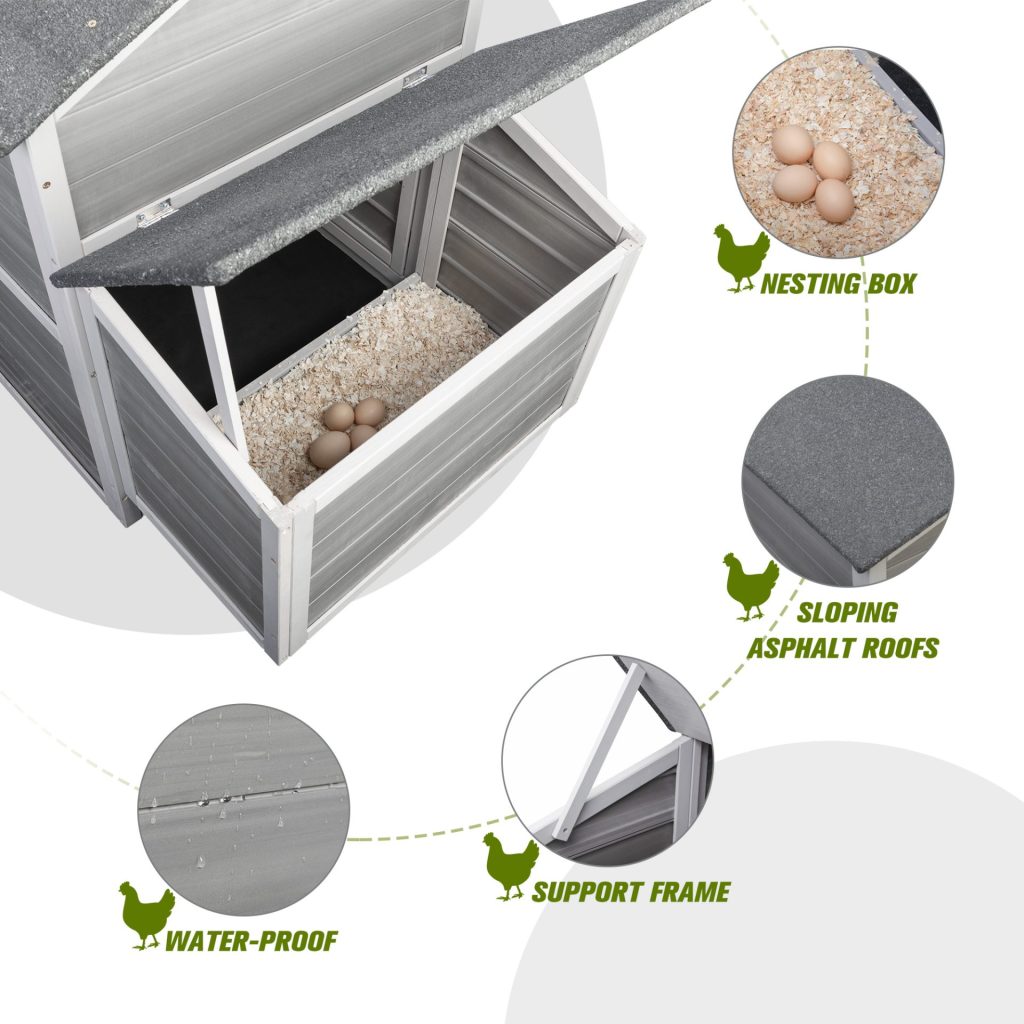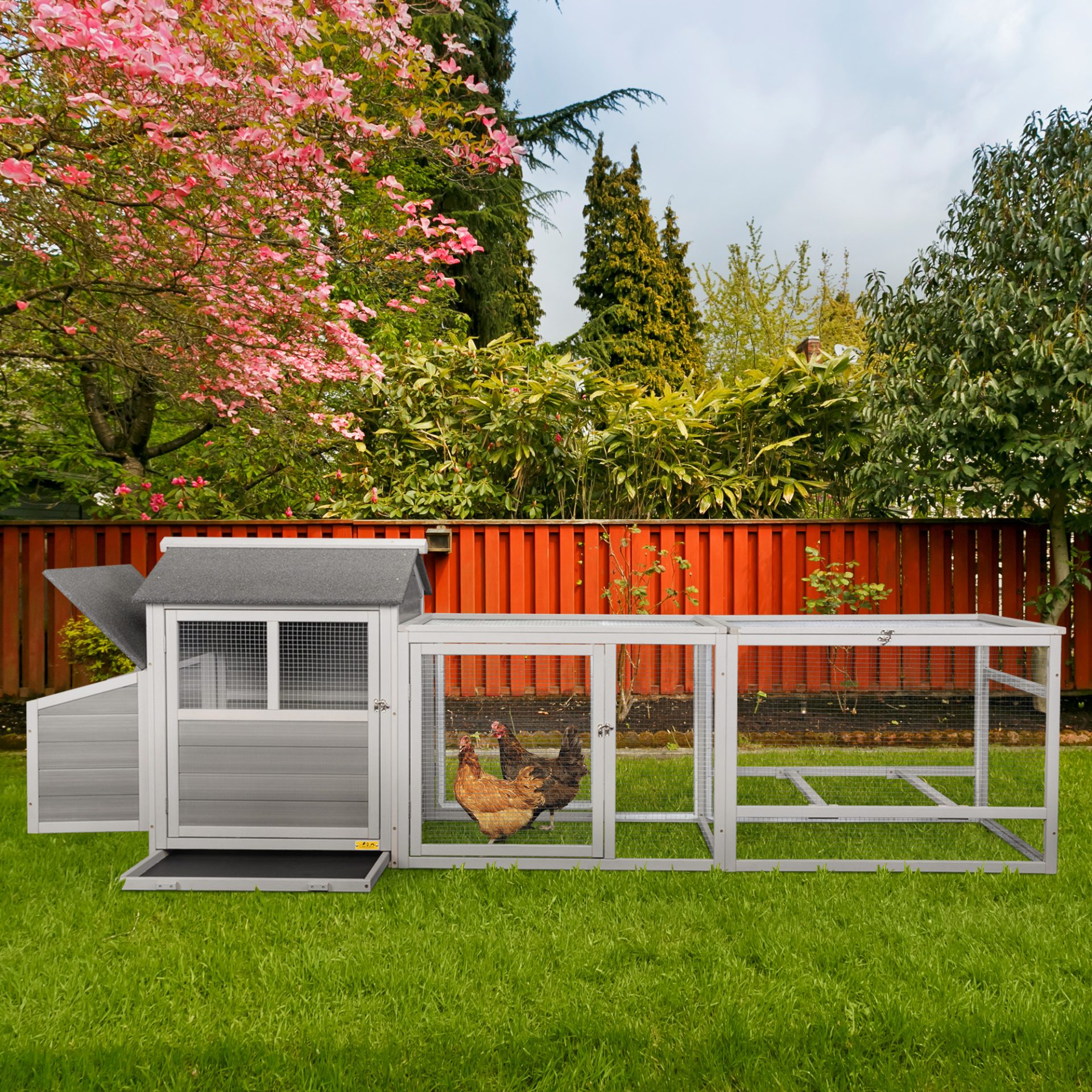Winterizing your chicken coop is an important part of preparing your flock for the colder months, but it doesn’t have to be difficult. These five simple steps will ensure that your feathered family has a successful winter!
#1. Create a Wind Block
Setting up a wind block around the enclosure is one of the first steps in winterizing your chicken coop. Cold winds can increase exposure and amplify the effects of cold weather on your flock during the winter. A windbreak also prevents winter precipitation from entering the enclosure.
Construction plastic is an excellent choice for creating a windbreak on the chicken coop enclosure. This plastic is available in large rolls that are large enough to cover the sides of the chicken coop enclosure. The plastic can be stapled to the chicken coop enclosure’s supports and battened down to keep the staples from coming loose.Boards screwed into the frame of the chicken coop enclosure work well as batons.
Tarps can be used in place of construction plastic, but they are darker in color and more difficult to work with. Dark colored wind blocks will not let light into your enclosure and may even absorb too much heat, making it too warm for your flock! Construction plastic is typically opaque, allowing light into the enclosure and creating a greenhouse effect within the enclosure without overheating it.
You can either place a wind block on the windiest side of your chicken coop enclosure or cover the entire enclosure in wind block plastic. Just make sure your enclosure still has adequate ventilation, air flow, and light. The north and west sides will generally receive the most direct wind, but this will depend on your geographic location and weather patterns.
This winter, winterizing your chicken coop enclosure with a wind block will help keep your flock warm and healthy. During the winter, windbreaks provide the following main benefits to your flock:
- Reduces exposure from the wind chill and precipitation.
- Decreases the chances of frostbite since the wind chill and exposure is limited.
- Helps prevent cold stress
- Keeps the enclosure dry and warm
#2. Chicken Coop Ventilation
Next, think about the ventilation in your chicken coop. A chicken coop should have good ventilation all year, but it is especially important in the winter. You don’t want to insulate and close up your coop so much to keep in heat that it compromises ventilation.
Ventilation is essential in the winter for the following reasons:
- Proper ventilation reduces ammonia fumes, which can cause respiratory and sinus problems in poultry.
- Proper ventilation prevents frostbite by allowing moisture to escape the coop, and moisture is the primary cause of frostbite.
- It aids in the management of dust levels in the coop, which can cause respiratory issues.
- Proper ventilation allows for proper air exchange within the coop, allowing old, stale air to be replaced with fresh, oxygen-rich air.
You want to ensure that your coop has adequate ventilation without being drafty. Drafts prevent air exchange and allow cold air to enter the coop without promoting air flow. To ensure that your coop has good ventilation while still promoting a warmer environment within the coop, have windows that can be opened and closed partially, or drapes over open windows. You can also make ventilation holes.
Ventilation holes should be placed near the coop’s roof. It may appear counterintuitive because warm air rises and exits the ventilation holes. However, that warm air will also bring out moisture with it thus creating a dryer coop that prevents frostbite and will help your chickens stay warmer.
With windows and drapes, you can open them partially to allow for air exchange and completely close them on extremely cold days or nights. Drapes are useful for windows that are constantly open because they trap some of the warm air inside the coop while still allowing for air exchange. This winter, having good ventilation in your chicken coop will keep your flock healthier and the coop fresh and clean.
#3. Use an Insulating Litter Like Straw
The third step in preparing the chicken coop for winter is to gather some straw. Whether you use wood shavings, sand, or straw as a year-round litter in your coop, you’ll need some straw for the winter. You can put straw in the enclosure even if you don’t use it as coop litter.
Straw is the best winter coop or enclosure litter because it offers so many benefits to your flock!
- Straw, when used in the coop, can help insulate it and keep it warmer than the outside temperature. • Straw, when used in the enclosure, helps insulate the ground and prevent frostbite on toes and feet.
- Straw is a healthy boredom buster for your flock during the winter. • It helps prevent cold stress by providing insulation and a motivation to get moving and warm up as your flock sorts through the straw.
- As straw composts with the droppings of the chickens, it generates natural heat, which can be beneficial in both the coop and the enclosure.
- Using straw as a deep litter makes winter maintenance of the chicken coop and enclosure much easier.
Determine whether you want to use straw as a coop litter, an enclosure litter, or both to winterize your coop. No matter where you decide to use straw, you should encourage composting. You can create a deep litter that will provide warmth and insulation by stirring in your flock’s droppings and constantly adding fresh straw.
Straw is a must-have winter litter for both the chicken coop and the enclosure!

#4. Keep Water from Freezing
Preventing water from freezing is probably one of the most difficult aspects of winter chicken keeping. This is the fourth and final step in winterizing the chicken coop. Create a system to keep your flock’s water from freezing, ensuring that they always have access to fresh, unfrozen water.
Dehydration can be a serious problem in the winter when your flock is exposed to cold, dry air!
Methods of keeping water from freezing are classified into two types: those that require electricity and those that do not. Methods that require electricity will be more reliable in extremely cold temperatures than methods that do not. The method you choose will be determined by how dependable you want the system to be and how much daily maintenance you can devote to your flock on cold winter days.
Here are a few popular methods for providing your flock with unfrozen water during the winter:
- The heated water base for poultry from Farm Innovators is a very dependable method for keeping plastic water founts from freezing.
- Heated pet dishes are effective for providing unfrozen water.
- Creating a system that allows a small ball or bottle to bob in the water will keep the water moving and keep it from freezing in mild winter temperatures.
- Wrap heat tape around water systems to keep the water from freezing.
- While black bowls placed in sunny locations can absorb heat from the sun and keep water from freezing for a short period of time, this method also promotes the growth of algae in the bowls.
- Creating a solar cover or greenhouse effect around the water system can aid in the trapping of warmth and the prevention of water freezing.
If you live in an area with extremely cold temperatures, you should invest in a dependable method for keeping your flock’s water from freezing. Otherwise, you’ll have to check their water every couple of hours when it’s below freezing. Developing a method to keep water from freezing is a critical component of winterizing the chicken coop!
#5. Have a Plan for Providing Supplemental Heat
The final step in preparing your coop for the winter months is to devise a plan for dealing with extreme weather conditions. You’ve probably heard that providing supplemental heat for your flock during the winter is a bad idea. However, in some cases, it may be necessary. Chickens can handle cold weather extremely well if they are given enough time to adjust to the colder temperatures, which is what happens naturally in the fall as the temperatures gradually drop. It is only when the temperature changes dramatically or remains extremely cold for an extended period of time that your flock will suffer.
Cold stress is caused by abrupt weather changes and extended periods of extreme temperatures. Cold stress suppresses the immune system, depletes extra body resources, and impairs metabolism, causing the chicken to be unable to produce enough energy to keep all of its bodily functions functioning normally. This is the time to provide some additional heat. Providing supplemental heat during periods of extreme cold stress will help keep your flock healthy all winter. It will give the chicken’s body a little boost, allowing it to stay warm and functional during the extreme weather. Under the following conditions, additional heat can be provided:
- Temperatures remain below freezing for an extended period of time (e.g. several days and nights).
- Temperatures suddenly drop from mild to cold; this can happen in the fall before your flock has adjusted to winter temperatures.
- The temperature has dropped into the negatives.
Don’t think of supplemental heat as making your chickens sweat. That is not going to help! Supplemental heat should be provided at no cost or used to keep the coop temperature around 32°F until outside temperatures rise above freezing. Free-choice heat is the best because it allows the chickens to choose whether or not they want extra heat.
There are several safe ways to provide additional heat:
- Heat pads- small animal heating pads are a great free-choice heat source that your chickens can use if they want to get warm.
- Poultry heating panels- similar to the pads, your flock can choose to stand near the heat panel if they want to get warm.
- Enclosed space heaters- these can be used if you have an area in your coop that the chickens can’t access, such as a storage area.
If you use straw as coop litter, never use a heat lamp. Straw is extremely flammable, and heat lamps pose a fire risk in the coop. Also, only use the supplemental heat for as long as necessary. Your flock should not require any additional heating throughout the winter.
Also, keep in mind that if the power goes out, the heat source will cease to function. If your flock is reliant on heat, this can cause stress and cause more harm than good. If there is a high likelihood of a power outage, you are better off not providing supplemental heat at all and instead doing other things to keep your flock warm, such as providing a healthy snack before roosting time and using the deep litter method in the coop. Only use supplemental heat if it will keep your flock warm and healthy this winter!
A Happy, Healthy Winter
Winterizing the chicken coop will ensure that your flock stays warm, healthy, and stress-free this winter! A winterized chicken coop will also help with winter chicken care. The five key steps to winterizing your chicken coop are to build a windbreak around the enclosure, make sure your coop is well ventilated, get some straw for the coop enclosure litter, set up a water heating system to keep water fountains from freezing, and have a plan for providing supplemental heat if necessary. Once you’ve mastered these five steps, you should be set for a successful and healthy winter with your flock!

